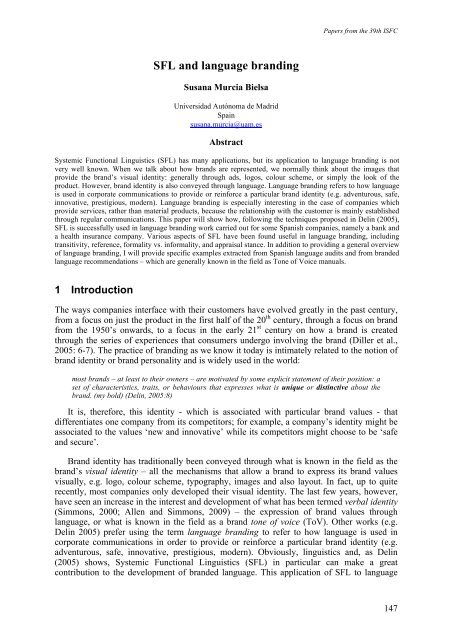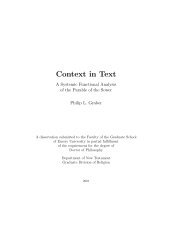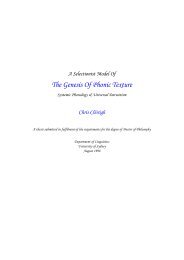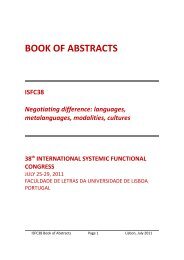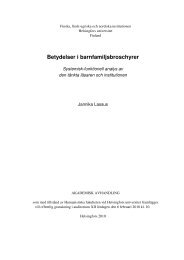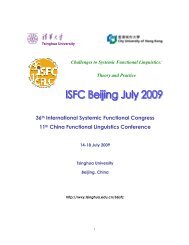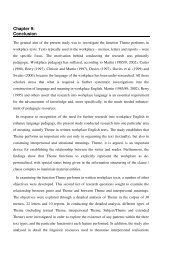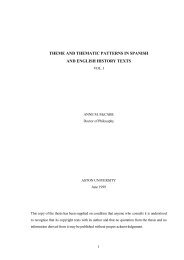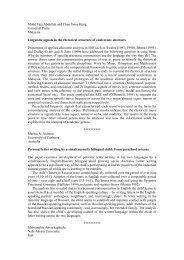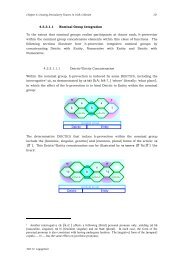the ISFC39 Proceedings - International Systemic-Functional ...
the ISFC39 Proceedings - International Systemic-Functional ...
the ISFC39 Proceedings - International Systemic-Functional ...
Create successful ePaper yourself
Turn your PDF publications into a flip-book with our unique Google optimized e-Paper software.
Papers from <strong>the</strong> 39th ISFCSFL and language brandingSusana Murcia BielsaUniversidad Autónoma de MadridSpainsusana.murcia@uam.esAbstract<strong>Systemic</strong> <strong>Functional</strong> Linguistics (SFL) has many applications, but its application to language branding is notvery well known. When we talk about how brands are represented, we normally think about <strong>the</strong> images thatprovide <strong>the</strong> brand’s visual identity: generally through ads, logos, colour scheme, or simply <strong>the</strong> look of <strong>the</strong>product. However, brand identity is also conveyed through language. Language branding refers to how languageis used in corporate communications to provide or reinforce a particular brand identity (e.g. adventurous, safe,innovative, prestigious, modern). Language branding is especially interesting in <strong>the</strong> case of companies whichprovide services, ra<strong>the</strong>r than material products, because <strong>the</strong> relationship with <strong>the</strong> customer is mainly establishedthrough regular communications. This paper will show how, following <strong>the</strong> techniques proposed in Delin (2005),SFL is successfully used in language branding work carried out for some Spanish companies, namely a bank anda health insurance company. Various aspects of SFL have been found useful in language branding, includingtransitivity, reference, formality vs. informality, and appraisal stance. In addition to providing a general overviewof language branding, I will provide specific examples extracted from Spanish language audits and from brandedlanguage recommendations – which are generally known in <strong>the</strong> field as Tone of Voice manuals.1 IntroductionThe ways companies interface with <strong>the</strong>ir customers have evolved greatly in <strong>the</strong> past century,from a focus on just <strong>the</strong> product in <strong>the</strong> first half of <strong>the</strong> 20 th century, through a focus on brandfrom <strong>the</strong> 1950’s onwards, to a focus in <strong>the</strong> early 21 st century on how a brand is createdthrough <strong>the</strong> series of experiences that consumers undergo involving <strong>the</strong> brand (Diller et al.,2005: 6-7). The practice of branding as we know it today is intimately related to <strong>the</strong> notion ofbrand identity or brand personality and is widely used in <strong>the</strong> world:most brands – at least to <strong>the</strong>ir owners – are motivated by some explicit statement of <strong>the</strong>ir position: aset of characteristics, traits, or behaviours that expresses what is unique or distinctive about <strong>the</strong>brand. (my bold) (Delin, 2005:8)It is, <strong>the</strong>refore, this identity - which is associated with particular brand values - thatdifferentiates one company from its competitors; for example, a company’s identity might beassociated to <strong>the</strong> values ‘new and innovative’ while its competitors might choose to be ‘safeand secure’.Brand identity has traditionally been conveyed through what is known in <strong>the</strong> field as <strong>the</strong>brand’s visual identity – all <strong>the</strong> mechanisms that allow a brand to express its brand valuesvisually, e.g. logo, colour scheme, typography, images and also layout. In fact, up to quiterecently, most companies only developed <strong>the</strong>ir visual identity. The last few years, however,have seen an increase in <strong>the</strong> interest and development of what has been termed verbal identity(Simmons, 2000; Allen and Simmons, 2009) – <strong>the</strong> expression of brand values throughlanguage, or what is known in <strong>the</strong> field as a brand tone of voice (ToV). O<strong>the</strong>r works (e.g.Delin 2005) prefer using <strong>the</strong> term language branding to refer to how language is used incorporate communications in order to provide or reinforce a particular brand identity (e.g.adventurous, safe, innovative, prestigious, modern). Obviously, linguistics and, as Delin(2005) shows, <strong>Systemic</strong> <strong>Functional</strong> Linguistics (SFL) in particular can make a greatcontribution to <strong>the</strong> development of branded language. This application of SFL to language147


